
How to Grip a Curve Ball
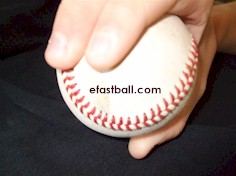
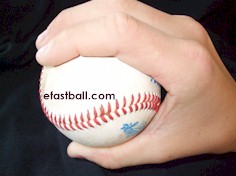
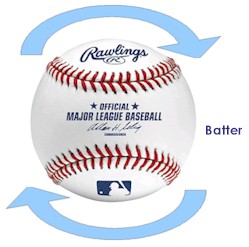


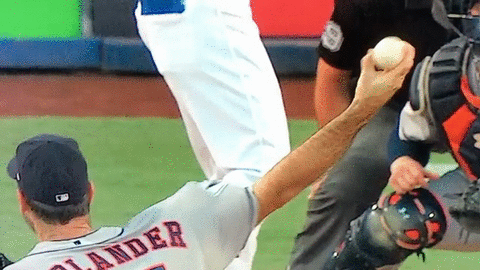
(not supinated)
- 10/7/2020 - Corrected pronation/supination discussion. Added Pronation demo gif.
- 11/18/2013 - Refreshed current curveball pitcher list, and added Mordecai Brown
- 4/4/2010 - Removed injury myth and added latest injury studies
- 5/2008 - Initial page
AKA
This pitch is a type of breaking pitch, also called a hook, hammer or a yakker.Position the Ball
2 seam fastball position Turn the ball where the seams run the direction of your fingers and the closed end of the horseshoe (the "U") is away from your palm.Position your fingers
Place your first two fingers (index and middle fingers) on top with your middle finger touching the inside of the seam. Your index finger is on the leather just next to your middle finger.Position your thumb
Place your thumb under the ball directly opposite the middle finger.Exert Pressure
Squeeze the ball with your thumb pushing against your middle finger.Delivery and Release
Roll your fingers over the top of the ball on release. Your hand will pronate just like a fastball (thumb down, inward, clockwise LH, counterclockwise RH), but the index finger is on the right half of the ball, so the ball rotates in the opposite direction from a fastball.Compared to other grips
This pitch is 10 to 20 mph slower than a fastball and may be a few mph slower than a change up. Since the ball rotates from top to bottom (vs. bottom to top) as seen by the hitter, it tends to drop faster than a changeup or a fastball.What the hitter sees
This ball goes above the hand then the ball drops down (or across) to the hitter.The seams will either appear as a one inch red circle or a pink blur (like a fastball) depending on the initial position of the ball (2 seam or 4 seam).
Alternate grip
Rotate the ball similar to a four seam fastball where the seams go across your fingers. Turn the ball where the horseshoes (the "U") run sideways. Lay your middle finger against the inside of the right seam.Place your thumb directly under the ball on the smooth part of the baseball (no seam).
When to throw
This is alternated with the fastball in order to upset the timing of the hitter.What it does (movement)
The ball will move down and to the left for a right handed pitcher. For a left hand pitcher, it moves down and to the right.The pitch creates a tight downspin rotating from top-to-bottom as viewed by the hitter. This is opposite from the backspin on a fastball. It creates a high pressure area on top of the ball, sending the ball downward at a faster rate than the hitter expects. This drop can break (or drop) from 7 to 20 inches.
Reaction Time
The hitter has roughly 0.45 to 0.50 seconds to hit this pitch.Typical Speed
This pitch is 10 to 20 mph (average 15 mph) slower than a fastball and may be a few mph slower than a change up. It is the slowest breaking ball (slower than a slider).| 10 and under | 25-35 mph |
| 11-12 | 35-45 mph |
| 13-14 | 40-60 mph |
| High School | 60-70 mph |
| College/ Pro | 65-80 mph |
The average speed of a curveball in the majors is 77 mph.
The ball will typically slow down 8-10 mph by the time it reaches the front of the plate. (Note that your home radar gun may stop reading well before the ball reaches the plate because the hitter is in the way.)
Catcher's Sign
Usually the catcher and the pitch caller use two fingers (or wiggle some fingers) to call a curveball.Great Curveball Pitchers
Clayton Kershaw, Jon Lester, Zack Greinke, and Chris Carpenter are some of today's curveball throwers.Dwight Gooden, Nolan Ryan, Bob Feller and Sandy Koufax were great curveball pitchers.
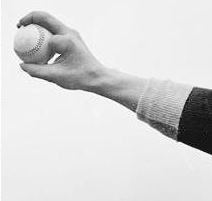
But, unfortunately most will not be able to duplicate his grip, since he lost a finger in a feed chopper.
Origin of the CurveBall
Either Fred Goldsmith (demonstrated it in 1866) or Candy Cummings (in a game in 1867) created the curveball.Injury Notice [updated]
The latest studies indicate that, despite previous "common knowledge" and "studies" from as far back as the 1950s, "curveballs are not the problem" when it comes to baseball pitching injuries - "overuse is"."I'm not saying, everyone throw the curveball. I'm saying, if we're going to prevent injuries, change the focus. We should be looking at overuse."Fleisig 2006: The self-described curveball does not produce more elbow torque than the self-described fastball of college pitchers
- Dr. Glenn Fleisig, American Sports Medicine Institute
Nissen 2009: The self-described curveball produces less elbow torque than the self-described fastball of high school pitchers
Dun 2008: The self-described curveball produces less elbow torque than the self-described fastball of youth pitchers
